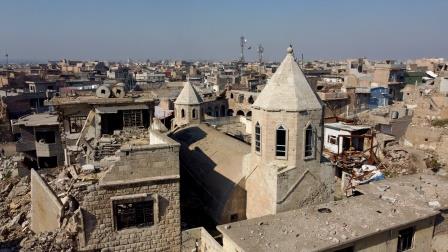MOSUL (IRAQ) – Four churches belonging to different denominations are situated in a small square in the Iraqi town of Mosul adjacent to the Biblical city of Nineveh. They stand as testimony to the role Iraq’s once-flourishing Christian community played.
Sadly, all four churches are either damaged or destroyed today after the Islamic State (IS) militants occupied the city from 2014-2017, desecrating many of the buildings and using them to run its administration.
More damage was done by air strikes by Iraqi forces to dislodge the militants. The walls still standing are riddled with bullet and shrapnel holes.
“It used to be a bit like the Jerusalem of the Nineveh plains,” said Mosul and Akra’s Chaldean Archbishop Najeeb Michaeel of “Church Square”. The name was given to the site that Pope Francis will visit on March 7 during his epoch-creating visit to Iraq.
Michaeel recollects how before the US invasion in 2003, Iraqi Christians from different denominations would attend each other’s services on religious holidays.
Today, those days are just a fading memory. Just one of Mosul’s surviving churches offers a weekly Sunday service to a Christian population that has dwindled top just a few dozen families from 50,000 people.
Around the square are located a Syriac Catholic, Syriac Orthodox, Armenian Orthodox and Chaldean Catholic church in ruins.
Pope Francis is slated to hold prayers for the victims of the war at Hosh al-Bieaa, known as Church Square in English during his four-day trip which Archbishop Michaeel described as highly symbolic.
“Where stones fell because of violence, there will always be life,” he said.
Workmen are cleaning up the site before the visit of the pontiff.
The UAE-funded restoration of the Syriac Catholic church of Al-Tahera is being carried out by UNESCO by collaborating with local partners and began in 2020.
Assistant site coordinator for UNESCO in Iraq Anas Zeyad displayed pictures of the church before its destruction while pointing to delicate Syriac carvings on greyish alabaster stone locally known as “Mosul marble”.
The church, which was damaged by IS before its roof was blasted by airstrikes, was used as a tribunal by the religious police of the militants.
Distinguished by its dome, the adjacent Armenian Orthodox church is closed off to the public.
“It has not been de-mined yet,” Zeyad said, pointing to the sealed door of the building which was used by the IS as a prison.
“Nearly all churches in Mosul were used by Islamic State,” Archbishop Michaeel said.
Standing next to a damaged piece of alabaster representing the Virgin Mary, Ali Salem of Iraq’s State Board of Antiquities and Heritage said his team was scrutinising such artefacts to find out if they could be repaired and used agains.
“As a Muslim, I am proud to help rebuild these churches,” Zeyad said, adding that he hoped “we see Christians come back to these places so that we live together again as we have for centuries.”













